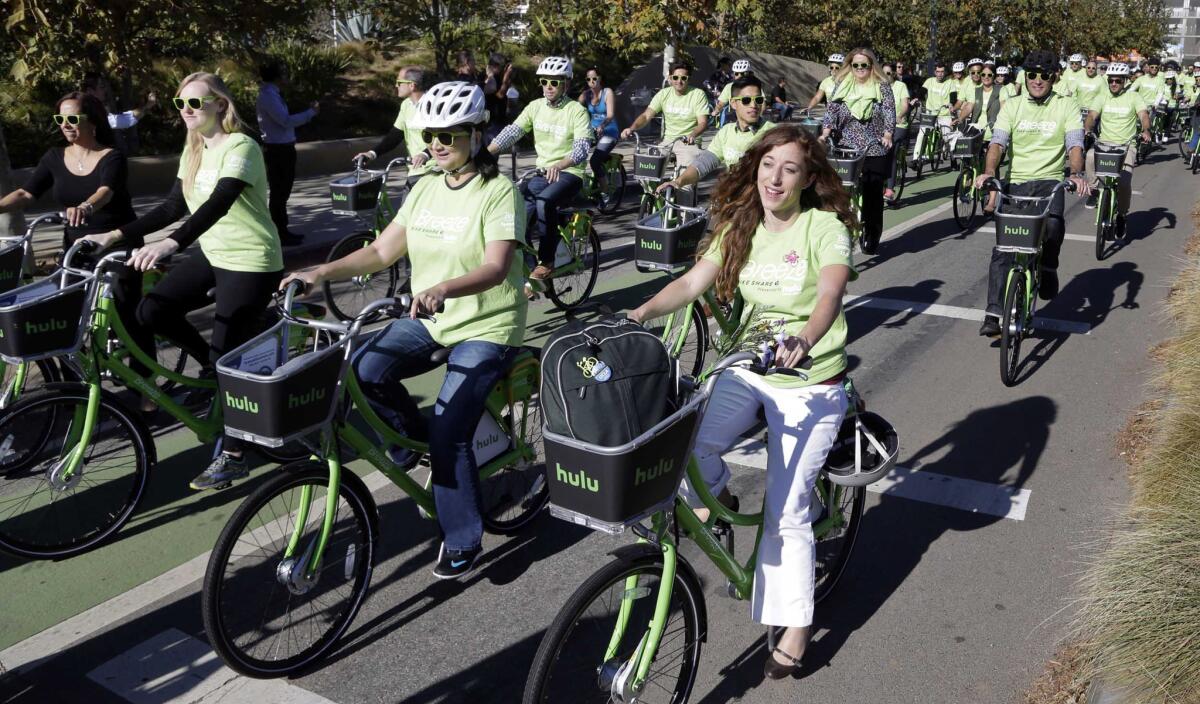Bike-sharing program gets going in Santa Monica, Venice; more areas to follow

After years of false starts in bringing bike-sharing programs to Los Angeles County, supporters celebrated the launch Thursday of the region’s first fully functioning program serving Santa Monica and neighboring Venice.
The debut begins to catch Southern California up with cities around the world that have welcomed bike sharing as a convenient, affordable way to make short trips without a car.
But potential kinks remain to be ironed out as more such programs spread across the region in the next several years. Most notably, the Metropolitan Transportation Authority is pushing forward with a separate bike-share program, using different bikes and a different payment model, prompting concerns that dual systems could confuse or frustrate consumers.
“I hope it’s not too late for Metro to reconsider,” Santa Monica Mayor Kevin McKeown told The Times. “We’re very concerned that they have continued to indicate that they’ll go with an old-fashioned system that will not easily integrate with Santa Monica.”
Santa Monica’s program, Breeze Bikeshare, is deploying 500 bright-green rental bikes at 75 racks in Santa Monica and four in neighboring Venice, in the city of Los Angeles.
The service is intended for short, point-to-point trips rather than all-day rentals. Customers will pick up a bicycle from a Breeze kiosk, or a nearby bicycle rack, and can drop it off at a rack near their destination. During a two-month test phase, the average ride lasted 15 to 20 minutes and spanned a little more than a mile, McKeown said.
Bike-share systems in some major U.S. cities, including Chicago and New York, rely on kiosks where users must pay their rental fee and can unlock a bicycle. The bikes must be returned to one of the program’s kiosks.
Those systems have encountered problems and the majority have been unprofitable. Some, like New York’s CitiBike, have faced unexpectedly high operational costs for maintenance and redistributing bikes to empty docking stations.
In Santa Monica, the shared bikes are equipped with GPS and a scanner that will read pre-purchased membership cards or Metro’s fare cards. The bikes can, in theory, be left at any rack in the city, which could eliminate the need to redistribute bikes to docking stations. Users will pay an extra $2 if they don’t return the bikes to special rental racks.
“The bikes are entirely self-contained, which is the beauty of the system,” McKeown said. Users will be able to find and reserve bikes using the Social Bicycles app, available for iPhone and Android.
Long Beach, Beverly Hills, West Hollywood and UCLA have all selected the same vendor as Santa Monica for their bike-share systems — which means they will be compatible.
“The Westside is really leading the way on this,” McKeown said. “Metro chose an old, tired system.”
Metro planning manager Avital Shavit said bike sharing is a relatively new industry, and many of the companies “are very much like start-ups.” Metro opted for a company that meets “industry standards and best practices,” she said.
Los Angeles has been discussing bike sharing for half a decade. In 2012, then-Mayor Antonio Villaraigosa announced plans for a system that was scuttled less than two years later.
In 2014, Metro began laying ambitious plans for a system that would include rental stations in cities across the county.
During the bidding process for the $11-million contract, Metro staff scored Santa Monica’s vendor the lowest of the four companies that expressed interest. That vendor did not have enough experience, and its technology was too new to prove “viability and large-scale reliability,” staff said.
The vendor Metro chose, Bicycle Transportation Systems, proposed a program similar to that found in several major U.S. cities.
Slated to begin offering service in the spring, the initial Metro system will include 1,100 bikes in an area extending from downtown to the University of Southern California campus near the Coliseum. Customers will be allowed to return rentals to any kiosk. Payment, via a fare card, will be accepted only at the kiosks.
Metro plans to expand the system to Pasadena in 2017, with the service possibly to be added later in Hollywood, Venice and East Los Angeles.
In general, officials are hoping a combination of rental fees and sponsorship agreements will roughly cover the costs of both the Santa Monica and Metro programs.
The Metro system will cost about $40.3 million to operate until 2022, with about half the cost recovered from rental fees. Metro, the city of Los Angeles and Pasadena would split the remainder of the costs. Metro is seeking a sponsor that could pay up to $18.4 million for naming rights for its program. New York’s program is partly underwritten by CitiBank, and Santa Monica’s by Hulu.
Santa Monica’s program will cost about $10.4 million to operate for eight years, the city said, and will bring in about $1.5 million in revenue annually from rental fees and sponsor payments.
Until the end of the year, a yearlong membership in Santa Monica will cost $99 and include one hour of daily riding time. Rates will increase after that to $119 for an annual pass. Santa Monica also offers monthly memberships for $20, a student pass for $47 per term and a pay-as-you-go-option, which costs $1 for every 10 minutes.
For more transportation news, follow @laura_nelson on Twitter.
ALSO:
Bike-sharing as a bridge between commute gaps
From a bicycle seat, she can really see Los Angeles
San Diego bike-share program hits snags over modest use, rental locations
More to Read
Sign up for Essential California
The most important California stories and recommendations in your inbox every morning.
You may occasionally receive promotional content from the Los Angeles Times.











